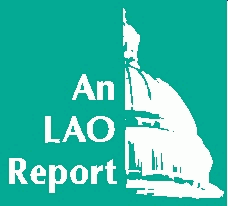

Background |
The California Veteran Farm and Home Purchase Program, known as
the Cal-Vet loan program, has provided more than 400,000 California
veterans of various wars the opportunity to buy a farm or home through
state assistance.
The Cal-Vet loan program is currently not competitive with other
private- and public-sector loan programs which now offer better interest
rates and terms. Significant financial and operational problems have
eroded the state's equity (assets less liabilities) in the Cal-Vet fund by
$200 million. Recently, the Department of Veterans Affairs has undertaken an
effort to fix the program's major problems and stem Cal-Vet's
financial losses. Nonetheless, the total number of Cal-Vet loans is likely to
continue to dwindle. Veterans do have other growing needs that are likely
to create pressure for more General Fund spending.
In the short term, the Legislature should: In the long term, the Legislature should: |
|
LAO Findings | |
|
LAO |
Program Creation. The California Constitution (Article XVI, Section 6) authorizes the use of
state money or credit to help war veterans acquire
or pay for farms or homes. In 1921, the
Legislature created the California Veteran Farm and
Home Purchase Program, known as the Cal-Vet
program, to provide such assistance to the veterans
returning from World War I. The program currently
operates under the authority of the Veterans Farm
and Home Purchase Acts of 1943 and 1974 and various bond acts set forth in the state Military
and Veterans Code.
Since its inception 77 years ago, the state has assisted more than 400,000 California veterans
of World War I and World War II, as well as those serving on active duty during the Korean,
Vietnam, and Persian Gulf conflicts. The vast majority of
state assistance has been provided for the purchase
of single-family homes, although some farm and mobilehome purchases have also been
financed through the Cal-Vet program. California is one
of five states to operate such a program. The
others are Alaska, Oregon, Texas, and Wisconsin.
Contracts for Loans. Technically, the Department of Veterans Affairs (DVA) operates a home purchase rather than a home loan program. The DVA purchases new and existing homes, farms, and mobilehomes that have been selected by an eligible war veteran. The state then resells the
property in accordance with a contract
requiring installment payments by the veteran. Despite
this technical distinction, the program operates
very much like a conventional home loan program.
In effect, Cal-Vet makes home loans similar to those
of other lenders. War veterans participating in
the program make monthly mortgage payments just like any typical borrower.
All loans are only for owner-occupied property. Moreover, Cal-Vet does not refinance loans
on property a veteran already owns. However, a veteran who received a Cal-Vet loan and paid it
off may apply for a subsequent loan.
Statutory Purpose. Notably, state law does
not explicitly mandate that the Cal-Vet program
provide loans at lower interest rates or with easier
terms than could be obtained from other lenders.
Rather, the statutorily defined mission of the
Cal-Vet program is "to provide veterans with the
opportunity to acquire farms and homes."
Historically, however, war veterans have often been able
to obtain Cal-Vet contracts with more favorable
terms than they would otherwise have been able to receive from private-sector banks or savings
and loans. The DVA has adopted a mission statement declaring the purpose of the program as
providing "low-cost, low-interest financing" to eligible
veterans "to recognize the sacrifice and service of
our veterans in the armed forces."
Except for some older loans carrying an
interest rate of 4.4 percent and some mobilehome loans
set at 9 percent, most borrowers currently pay
the equivalent of an 8 percent interest rate under
the Cal-Vet program. In accordance with state law,
this interest rate is subject to upward or
downward revision throughout the life of the loan by the DVA. By law, Cal-Vet may provide up to 95 percent
of the financing needed for most home purchases, with the veteran providing a 5 percent
down payment.
During 1996-97, the Cal-Vet program provided $143 million in financing for 967 new
property purchases, for an average of about $148,000
each. The Cal-Vet program also provided about
$2.8 million for 242 home improvement loans
averaging about $12,000 during the same fiscal year.
State law also authorizes the DVA to operate several insurance programs in conjunction with
the Cal-Vet program. Veterans participating in the program are charged fees to pay for (1) fire
and hazard insurance; (2) a disaster indemnity
plan covering losses for floods, earthquakes, and
other perils; and (3) insurance coverage providing
for repayment of the Cal-Vet loan in the event a veteran dies or becomes disabled.
However, conventional property mortgage insurance is
not now required for Cal-Vet loans.
Bonds Are Funding Source. The Cal-Vet program has been funded over its life through the sale
of more than $9 billion in general obligation
bonds and revenue bonds. The current outstanding
state debt, which amounts to about $3 billion, is
being repaid from payments made by Cal-Vet
borrowers and cash generated from other investments of
Cal-Vet funds. As of last year, the interest rate on
the outstanding debt of the Cal-Vet bonds ranged
from about 3.5 percent to 11 percent.
Roughly 90 percent of the outstanding debt
for the program consists of general obligation
bonds, so-called because the full faith and credit of
the state is pledged for repayment in the event
that contract payments from veterans were ever
insufficient to pay the debt service. (This situation
has never occurred.) California voters have
approved 25 such bond acts, most recently
authorizing $400 million in additional debt through
Proposition 206 on the November 1996 ballot.
The remaining 10 percent of debt for the
program has originated from revenue bonds that
lack full state backing, and which are secured instead
by a pledge of the fund into which contract funds from participating veterans are deposited. The
sale of mortgage revenue bonds commenced in 1980.
As can be seen in Figure 1,
the overall level of debt in the Cal-Vet program
peaked about the beginning of this decade and his
been dropping steadily since that time.
Noncallable Bonds. About $900 million of
the current outstanding Cal-Vet debt—roughly
one-third of the debt total—originated from the sale of
bonds that are deemed "noncallable." Noncallable
bonds contain provisions that prohibit the Cal-Vet
program from paying off the bonds ahead of schedule.
In addition, about $575 million in bonds
contained provisions that prohibited prepayment until the
last five years of the life of the bonds. About $1.5 billionof the debt is subject to being "called" and can
be paid off at any time.
The proceeds of both general obligation and revenue bonds are continuously appropriated
by state law, and are specifically exempted from
the regular state budget process.
At the time this analysis was prepared, the DVA was proceeding with a major refinancing of
its existing bond debt as well as the issuance of additional bonds. The transaction, when
completed by May 1998, will amount to $1.6 billion in
new and refinanced debt. The main purposes of the transaction are to (1) replace some older,
higher-cost bonds with new, lower-cost bonds; and
(2) make new funds available to finance additional home purchases for veterans. We discuss
and comment on the DVA's debt transaction later in this report.
General Rules. The eligibility of veterans for
the Cal-Vet home purchase program is subject to various state and federal restrictions, including
the period of a veteran's military service, the
duration of the military service, the cost of the property
to be purchased, and, in certain cases, the
property location, the veteran's family income, and
whether the veteran is a "first-time home buyer."
Until now, assistance has been limited to veterans who served on active duty for a
statutorily defined wartime period—primarily World War
I, World War II, and the conflicts in Korea,
Vietnam, and the Persian Gulf—and who also received
an honorable discharge. Under a new DVA-sponsored state law (Chapter 155, Statutes of 1997 [Knight, It is no longer necessary that a veteran be
a California resident at the time he or she
entered military service in order to qualify for a
Cal-Vet loan. A 1992 California Supreme Court ruling (Del Monte v. Wilson) struck down such a
Cal-Vet requirement as a violation of the federal
constitutional right to equal protection of the laws.
Further restrictions apply to Cal-Vet
applicants, depending on whether assistance is provided
using the proceeds of general obligation bonds or
revenue bonds. In both cases though, these restrictions
apply to ensure that the bonds issued by the state are
tax exempt for the purposes of federal tax law.
The bonds' tax exempt status makes it possible for
the state to sell them at a lower interest rate than
would otherwise be possible.
The details regarding who may qualify for a
Cal-Vet loan are discussed in the shaded box (see page 6).
Shift to Department in 1943. At the time of its creation, the Cal-Vet program was administered
by the Veteran's Welfare Board. In 1943, the board was eliminated and its operational duties shifted
to the DVA.
During 1996-97, the program operated ten
California branch offices—eight full district offices and
two satellites with minimal staffing—under the
supervision of the central headquarters in Sacramento. The
DVA is now realigning the office config-uration to
provide five full district and five satellite offices. The location
of each of the office sites under the new configuration
is shown in Figure 2.
Of the 232 authorized positions associated with the Cal-Vet program, about 90 consist of personnel
in either district or satellite offices, about 60 are
program staff located at the Sacramento headquarters, 66
are administrative support functions (mainly data
processing, personnel, accounting, and legal services)
in Sacramento, and 16 are DVA managers.
The staffing and operating expenses of the
Cal-Vet program amounted to $20.2 million
during 1996-97. Of this amount, only about
$1.2 million for administrative support was directly
appropriated by the Legislature through the 1996-97 Budget
Act, with the balance coming out of the off-budget
Cal-Vet fund.
Applications for Cal-Vet loans have
historically been marketed and processed exclusively
through the program's network of branch offices.
Although other government loan programs give
private lenders the authority to place loans, that is not
the case in the Cal-Vet program. Subsequent
servicing of loans that have been funded, including
such activities as billing, delinquent accounts,
and repossession of defaulted property, has also
been handled by DVA branch offices in the past.
The Cal-Vet program is in the midst of a
reorganization that we discuss later in this report that will
consolidate key loan servicing operations in
Sacramento while leaving most marketing and loan
origination activities in the branch offices. Loans Financed With General Obligation Bonds. Cal-Vet loans financed with general
obligation bonds may be provided only to veterans who served on active duty prior to Loans Financed With Revenue Bonds.
Cal-Vet participants who receive loans funded
from revenue bonds are subject to different eligibility rules even though their loans carry the
same interest rate and terms as those funded through general obligation bonds. For example, there is
no requirement that the veteran had served on active duty before 1977 and no requirement that
the veteran apply for benefits within 30 years of active military duty. Also, loans cannot be made
to buy farms or for some mobilehome purchases.
Some nonveterans are eligible for revenue bond-supported loans. The surviving spouse of
a veteran who was eligible for a Cal-Vet loan may also be eligible for a loan if the veteran died
during the application process, if the veteran died from injuries received in the line of duty, or if
the veteran was a prisoner of war or was declared missing in action. Spouses are not eligible for
Cal-Vet loans supported by general obligation bonds.
A veteran who receives a revenue bond-funded loan must either be a "first-time home buyer"
or live in a neighborhood "targeted" for assistance due to low incomes of residents or
economic distress. A first-time home buyer is considered by law to be anyone who has not owned the
home in which they have lived for the last three years.
Unlike loans funded through general obligation bonds, those funded with revenue bonds
are subject to price limits. The price limits permit a larger amount of Cal-Vet assistance in targeted
areas and a lower amount of assistance in nontargeted areas. For example, as of July 1996, a
veteran receiving Cal-Vet assistance to purchase a new home in a targeted neighborhood in Los
Angeles could buy a home costing up to $281,800. A veteran buying a home in a nontargeted Los
Angeles neighborhood would be limited to a purchase of a home costing $230,563.
A veteran purchasing a home outside of a targeted area is also subject to family income
limitations. For example, a family buying a home in a nontargeted Los Angeles neighborhood could
have had an annual income of no more than $58,995 annually. Veterans Board and Finance Committee. The California Veterans Board also plays a
significant role in the operation of the Cal-Vet program.
The panel is composed of six members, who are appointed by the Governor and confirmed by
the Senate to terms of four years, and a seventh
ex officio member, the Secretary of Veterans Affairs.
A 1946 state law provides that the board
"shall determine the policies for all operations of
the department," and a more recent measure
(Chapter 1145, Statutes of 1996 [SB 1470, Johannessen]) mandates that the Secretary of the DVA not
make policy changes to DVA programs, including Cal-Vet, without "fully briefing" the board. The board
is also empowered to decide appeals of
departmental decisions on applications for Cal-Vet
program benefits.
The board is empowered to set the interest rate for Cal-Vet loans. A new state law
(Chapter 197, Statutes of 1996 [SB 785, Johnson]) deletes
a requirement that two-thirds of the board consent
to that decision, leaving the matter to a board
majority. A two-thirds vote would continue to be
required only if the board sought to change the interest
rate more than once within a calendar year.
Another panel, the Veterans Finance Committee of 1943, comprised of the Governor, the
State Controller, the State Treasurer, the Director
of Finance, and the Secretary of Veterans Affairs,
or their representatives, also has responsibility for
the Cal-Vet program. A majority of the finance
committee must consent to any decision by the
Veterans Board to change the Cal-Vet program interest
rate.
Chapter 197 deleted the requirement that
the finance committee, as well as the Veterans
Board, review and take action on the Cal-Vet interest
rate each year. Henceforth, the two panels need take
no action at all if the DVA concludes that no change
is needed in the Cal-Vet interest rate.
Our review and analysis of the Cal-Vet
program has led us to reach a number of
conclusions regarding its benefit to veterans and the
effectiveness of its operation. Our findings are discussed
in detail below and are summarized in Figure 3.
In its present form, the Cal-Vet program is
not competitive with other private- and
public-sector loan programs. Creditworthy veterans can
currently obtain better interest rates and terms
from private lenders with the help of other federal
and state agencies, including programs which
specifically target veterans and low-income
home buyers—Cal-Vet's customer base—for
assistance. Cal-Vet lending activity has dropped off
dramatically and many past participants in the
program are paying off their loans early and
borrowing from Cal-Vet's competitors because the
private-sector mortgage market and other
governmental mortgage assistance programs are meeting
veterans' needs.
The DVA's stated goal is to provide
eligible veterans with Cal-Vet loans on rates and terms
that are better than can be found elsewhere.
Throughout the 1970s and 1980s, the DVA
accomplished that goal and provided substantial benefits
to veterans. For example, when market interest
rates on 30-year fixed-rate home loans peaked at
above 17 percent during 1982-83, the rate for most
Cal-Vet loans was less than half of that—8 percent.
For a Cal-Vet veteran, that meant a savings in the hundreds of dollars on their monthly
mortgage payment.
The fees and terms for Cal-Vet borrowers also have compared favorably with its competitors
in the past. Unlike many private-sector borrowers,
Cal-Vet loan recipients are not required to pay
any "points" to obtain their loan, which sometimes
can cost several thousand dollars; the loan
origination fee is $50.
Moreover, unlike most private borrowers,
Cal-Vet has not in the past required a borrower to
obtain conventional property mortgage insurance
whenever the amount borrowed exceeds 80 percent of
the value of the purchased property. It is not unusual
for the premiums for such insurance policies to cost
a borrower in excess of $100 per month. Cal-Vet's
fire, disaster, and life and disability insurance
programs were low in cost and carried favorable terms with
low deductibles, providing an additional incentive to
a veteran to obtain a Cal-Vet loan instead of one
from the private mortgage market.
As can be seen in Figure 4, the Cal-Vet
program has largely lost the competitive advantage it
had long held over the private-sector loan market.
While Cal-Vet's rates have remained level, the
prevailing private-sector interest rates have dropped
steadily since their peak in the early 1980s. In
December 1997, at a time when most Cal-Vet loans carried
an 8 percent interest rate, fixed-rate
private-sector mortgages were available bearing about a 7 percent rate.
Cal-Vet's marketplace disadvantage is even more pronounced if Cal-Vet loans—which technically
are variable- and not fixed-rate loans—are compared
to variable-rate private-sector loans. In December 1997, 30-year adjustable-rate loans could
be obtained at an initial rate of 5.5 percent.
Thus, Cal-Vet has been unable to compete with the private sector on the basis of interest rates in
a highly price-sensitive mortgage market. This
market disadvantage appears to have overwhelmed
the benefits Cal-Vet borrowers would otherwise
enjoy from lower fees and better insurance coverage.
Cal-Vet also appears at a severe disadvantage
in competing effectively with the federal VA loan guarantee program.
Under the VA program, the federal government guarantees the repayment of a significant portion
of a home loan if a private lender issues loans in accordance with federally established terms
that are beneficial to veterans. Among VA's
advantages over Cal-Vet:�
Cal-Vet retains one significant marketplace advantage: its fees are significantly lower
than those charged to borrowers under the VA loan guarantee program. However, that advantage
is partly negated because the VA fees—which in
some cases can exceed $1,000—can be financed
through the loan and not paid up front. Cal-Vet and
VA loans are similar in that no additional
property mortgage insurance is required in order to obtain
a VA loan even when the loan exceeds 80 percent
of the value of the property being purchased.
Federal Housing Administration. The
Federal Housing Administration (FHA) also competes
with Cal-Vet in the California housing market through
a loan guarantee program (the Section 203 [b] program). The program is focused on
assisting lower-income home buyers and includes an element targeted specifically at assisting
military veterans.
As is true for the VA program, FHA borrowers pay a prevailing market rate that may be less
than Cal-Vet charges to borrowers. The FHA loans
can cover up to 97 percent of the cost of purchasing
a home, slightly more than the 95 percent
allowable under the Cal-Vet program. A special 203
(b) program for veterans allows an even smaller
down-payment.
Although FHA purchasers are subject to higher fees than under a Cal-Vet purchase, some of
those costs need not be paid up front and can be
added to the amount borrowed. However, the amount
of an FHA-guaranteed loan is much smaller than one can obtain under the Cal-Vet program. As of
1997, the maximum loan in high-cost areas was
about $155,000 compared to the $250,000 loan
allowed under Cal-Vet. Lower FHA loan limits applied
in other areas where living costs were lower.
California Housing Finance
Agency. Some California veterans have also obtained
single-family loans through the California Housing
Finance Agency (CHFA). Unlike the Cal-Vet program,
which markets its loans directly to customers, the
CHFA makes advance commitments of funds to its network of private-sector lenders, who in turn
lend the funds to loan applicants. The program
focuses on assisting first-time home buyers and
fostering home ownership in neighborhoods targeted
for revitalization efforts.
Except for the lack of any requirement of prior military service, the eligibility rules for the
CHFA loans are very similar to those established for
the Cal-Vet revenue bond loan program. The CHFA loans, however, have a significantly lower
interest rate than Cal-Vet loans. As of October 1997, at
a time when the Cal-Vet interest rate was 8 percent,
a 30-year fixed-rate CHFA loan carried a rate of between 6.5 percent to 6.75 percent depending
on the location of the home purchase. At least
3,000 outstanding loans in the CHFA portfolio (the
full number is not known) were made to veterans.
Cal-Vet New Loans Declining. Figure 5 shows that the number of new loans issued each year
by the Cal-Vet program has fallen sharply since
the early 1980s. Loan activity in 1996 exemplifies
this trend. The 1996-97 DVA business plan for the program anticipated that almost $170 million
in new loans would be issued. About $146 million
in loans were actually issued.
About five Cal-Vet loans were paid off
and retired for every one new borrower during 199697. Some of the loans were retired on
a normal pay-off schedule and others due to the death or delinquency of the borrower. About
68 percent were taken off of the Cal-Vet program's
books because a home sale or a loan refinancing resulted
in the early pay-off of the loan.
Certain demographic factors, which we discuss later in this report, appear to have
contributed partially to the fall-off of new loan activity. We
also believe the trend is related to the
corresponding decline in market interest rates during the period
in which these rates came in line with or dropped below the Cal-Vet program's rates.
Cal-Vet Portfolio Shrinking. This declining
trend of new loans has sharply diminished the
total number of loans in the Cal-Vet program
portfolio, as seen in Figure 6. That portfolio dropped
by 9 percent (about 4,200 loans) in 1995-96
and dropped another 9 percent (another 3,900 loans)
in 1996-97. The 39,000 loans in the Cal-Vet
portfolio as of June 30, 1997 is less than a
third of the number the program had at the start of the 1980s.
Cal-Vet's Loan Market Share Disappearing. Cal-Vet's share of the California home mortgage
market has always been small, but now has become
even smaller. In 1990, about four-tenths of 1 percent
of the $56 billion in home loans issued each
year were issued by Cal-Vet. Now Cal-Vet has about
a two-tenths of 1 percent share of a $59.6 billion
loan market.
In addition, the number of loans made each year to California veterans under the VA, FHA,
and CHFA loan programs dwarf the number issued by Cal-Vet. During federal fiscal year 199596,
$4.6 billion in VA-backed loans were issued to
32,976 California veterans. The FHA, also active in
the California market, assisted in financing
almost 105,000 loans involving $11.2 billion during
the 1995-96 federal fiscal year. (Of this total, 683
loans totaling $80 million were issued to
California veterans.) Meanwhile, CHFA originated 6,166
loans amounting to $656 million during the
overlapping 1995-96 state fiscal year. Cal-Vet issued only
984 new loans amounting to about $115 million
during 1995-96.
After years of contending otherwise, the DVA now has recognized that its loan terms are
no match for others in the private and public sector.
Its pending $1.6 billion plan to restructure its debt
is designed to lower the interest rate for most
outstanding Cal-Vet loans to between 6.75 percent
and 7 percent, and thus again make the
program competitive with the private market. The
new interest rate is expected to go into effect on April
1, 1998.
Even without these efforts by the DVA,
however, the private-sector home mortgage market and
other governmental mortgage assistance programs
are meeting veterans' needs. Creditworthy veterans have many options for obtaining home
purchase assistance in the current economic environment.
Significant financial and operational
problems in the Cal-Vet home purchase program,
some resulting from past mismanagement by the Department of Veterans Affairs and others not of
its making, eroded the state's equity in the
Cal-Vet fund. Almost every major element of the
program—from bond sales, investment of cash,
and handling of delinquent accounts to loan
origination, insurance programs, and customer
service operations—has suffered because
longstanding problems were allowed to continue
without corrective action and proper oversight for
many years.
Audited financial statements indicate that
Cal-Vet program expenses exceeded revenues by
$22.5 million during 1996-97. As can be seen in Figure 7, this
is the fifth year in a row that the program has
recorded a financial loss. It is also the eighth year in the
last eleven that a loss has been recorded.
These losses are not what administrators of the program had projected. A 1988
cash-flow projection prepared for the DVA suggested that
Cal-Vet revenues would outpace expenses by
$87 million during the five fiscal years ending in 1996-97.
The actual result was a combined loss of about $125 million.
The cumulative effect of these successive
annual losses has been an erosion of the state's equity
in the program. By state equity, we mean the
retained earnings that belong to the state after all
liabilities, such as the outstanding bond debt, have
been subtracted from the combined assets of the
program, such as its cash and pool of purchase contracts. The equity essentially represents the
financial return that has accrued over many years to
state taxpayers for the billions of dollars they
have invested in Cal-Vet mortgages for eligible veterans.
This equity, which was generated largely from the interest veterans paid on their loans and
from other investments of the program's cash
reserves, amounted to almost $458 million as of June
30, 1986. Because of the recurring losses over the
last 11 years of operation of the Cal-Vet program,
the state's equity has dropped to about $258 million
as of June 30, 1997. That is a $200 million, or
44 percent, decline during that period. This
downward trend is evident in Figure 8.
The long-term impact of these losses on
the state's equity appears to be even more
significant. Long-term cash-flow projections released by
the DVA in 1991 indicated that, once all
outstanding bonds had been retired and all Cal-Vet
mortgages were paid off, the state's remaining equity in
the program would exceed $1.6 billion. More
recent projections indicate that the state's
remaining equity at program's end would be less
than $600 million—$1 billion less than the prior
forecast. Part of the $1 billion differential is interest
earnings that were foregone because of the
unexpected decline in the Cal-Vet loan portfolio. Another
part of the $1 billion differential is the long-term
impact of past mismanagement of program finances
and operations.
Forces outside of the DVA's managerial control, we note, have contributed to
Cal-Vet's financial problems. These include statutory restrictions
that were imposed on the program long ago that are not appropriate in the highly competitive
loan market of the 1990s, major shifts in the
California economy and interest rates, and constraints
imposed through the federal tax code that have limited the program's potential market of
eligible veterans.
On the other hand, other governmental loan programs, such as CHFA, faced their own set
of constraints yet appear to have done a much
better job of responding to changing conditions in
the California mortgage market. While the Cal-Vet program was posting a $6.7 million loss in
199596, for example, the CHFA Home Mortgage
Revenue Bond Program was experiencing a
$21.5 million profit.
We do not believe the recent losses pose
any danger to the state's ability to pay off the bonds
out of program revenues. Cal-Vet continues to have more than sufficient cash and other assets on
hand to meet its obligations to borrowers and
bondholders. A September 1997 status report on the
program issued by the DVA stated that "cash
reserves of the Farm and Home Fund are more than
adequate for forecasted requirements." The
Cal-Vet program balance sheet shows that the
program Notably, program assets as of that date
exceeded 108 percent of the liabilities shown on its
balance sheet, in an enterprise where a 103 percent
asset coverage ratio is considered to be financially
secure by loan program experts. Assets in excess
of 103 percent may be removed from the
program and used for other purposes where
(1) other specific reserve requirements required for
insurance and bond issuance are met and
(2) program revenues will meet expenses for the remaining
life of the outstanding indebtedness.
The main reasons for the program's losses
are (1) a mismatch between interest earned by
the program and interest paid out for bonds,
(2) problems in Cal-Vet insurance programs, and (3) a
wave of delinquencies and foreclosures on Cal-Vet properties. Underlying all of these problems was
a history of weak program operations and management. We discuss these problems in more
detail below.
The Interest Rate Gap. For many years, the
Cal-Vet program borrowed money by selling bonds at relatively high interest rates and invested
the proceeds at lower interest rates. The results
were tens of millions of dollars in losses, known in
the bond business as "negative arbitrage." In
1994-95 alone, for example, interest payments by
the program exceeded interest earned by $15.6 million.
These losses occurred in part as a result of
earlier decisions by program managers and the
State Treasurer to issue noncallable bonds,
thereby locking in for 25 years relatively high interest
rates that the Cal-Vet program paid to bondholders.
For example, during 1980 through 1984, at a time when interest rates were at their peak in
modern times, the Cal-Vet program issued more than $1.5 billion in noncallable bonds at relatively
high interest rates ranging between 7.8 percent
and 11 percent. At the time, the sale of
noncallable bonds lowered the program's borrowing costs
by making them more attractive to prospective
buyers. While issuance of noncallable bonds might
have been to the Cal-Vet program's advantage had
rates been at a low point, the decision program
officials made was to lock in interest rates on bonds for
25 years at their peak in modern times.
In addition, other Cal-Vet cash was heavily invested in the State of California's Surplus
Money Investment Fund (SMIF). In the early 1980s,
SMIF earned as much as a 12 percent return and
such an investment made sense. But, as can be seen
in Figure 9, the interest rate earned for cash
invested in the fund dropped steadily over the years and
by 1994 was only about 4 percent. Cal-Vet
officials were slow to withdraw cash from SMIF and shift
it to higher-earning investments, resulting in
financial losses to the state in the tens of millions of dollars.
The problem was magnified during the 1980s as more and more Cal-Vet borrowers paid off
their loans early. Because such a large share of the
Cal-Vet debt consisted of noncallable bonds, the
DVA could not use the surge of incoming cash from
the Another critical factor in these losses is the single-interest rate structure of the program,
which is established in statute and not subject to
change by the DVA. During periods such as the
early 1980s when it was costly for the Cal-Vet
program to borrow money through bond issues, the
DVA did not have the flexibility to charge a
correspondingly higher rate to new Cal-Vet borrowers
unless the interest rate was also increased for almost
all other existing Cal-Vet loans. Had Cal-Vet
been granted the authority to more closely match
the interest rate it charges to veterans getting Cal-Vet loans with the interest rate it paid on the
bonds used to fund those loans, the financial losses
might have been minimized.
Life and Disability Insurance Program
Problems. In its marketing efforts, Cal-Vet
program officials have long stressed its low-cost,
high-coverage, and low-deductible insurance
coverages as an inducement to potential borrowers.
However, the DVA's past failures to set aside
adequate reserves, collect adequate premiums from
borrowers, or to properly limit the program's financial
risks have contributed significantly to the overall
financial losses suffered by the Cal-Vet program in
recent years.
Most of the losses since 1994 stem from the
life and disability insurance program. A review of
the program by the State Controller released in
April 1996 found that insurance claim payments
have generally exceeded premiums since 1983. This
is occurring because the population of Cal-Vet
loan recipients is aging and thus, not surprisingly,
suffering more frequently from physical disabilities
and filing claims against their coverage. The
Controller concluded that, from 1984 through 1995, the
life insurance program lost $29.6 million while
the disability insurance component lost $18.4 million.
The statutes authorizing the Cal-Vet program make clear the Legislature's intent that the
DVA maintain "appropriate and prudent" reserves for
the life and disability insurance programs and
that surplus funds are permitted to be used for
the general purposes of the loan program.
It now seems clear that the DVA did not
maintain adequate reserves to support the program
in the long term. A 1993 actuarial analysis
conducted by a DVA consultant found that the programs
were underfunded by $38.4 million as of June 1992.
The consultant concluded the programs had an unfunded liability due to, among other factors,
(1) insufficient premium rates, (2) use of funds to
subsidize a 1 percent cut in Cal-Vet interest rates
from 1987 to 1989, and (3) transfers of funds to
subsidize other Cal-Vet insurance programs. The
Controller concluded in a 1996 review that "the
financial instability of the program appears to have
continued to deteriorate" since 1992.
In order to remedy the underfunding problem, the DVA is now implementing changes in life
and disability coverage and premium levels, along
with the transfer of the program to a private
insurance firm. However, these actions are being
challenged in a pending Los Angeles Superior Court lawsuit
by Cal-Vet borrowers who contend that any changes in premiums and benefits should be
overturned and that $71 million of the state's equity in
the program should be placed in a special reserve
for the two insurance programs.
Although the reserves set aside for the
insurance programs were insufficient, it may well have
been legally permissible for them to be operated in
that fashion. Nonetheless, if the courts rule against
the state on this issue, it could create further
financial problems for the program.
Other Insurance Difficulties. The
Cal-Vet program has in the past often operated
without sufficient reserves in its other insurance
programs. During some years, these other programs
have suffered significant losses from fires,
earthquakes, and floods that have contributed to the
program's overall unprofitability.
A DVA consultant concluded that the programs have, at times, left the state vulnerable to
even greater financial losses. The financial weakness
in the programs was attributed to the insufficient premiums charged to Cal-Vet borrowers and
the deductibles and other terms of coverage that
have been much more generous than comparable commercial insurance policies. For example,
the disaster indemnity plan provides only a $250 deductible for each claim—significantly less
than commercial insurance policies requiring a
deductible equal to 25 percent or more of the value of
the insured property.
Delinquencies and Repossessions. The
Cal-Vet program has suffered major financial losses
in recent years as many borrowers became delinquent or defaulted on their loans. In addition to
the lost mortgage payments, the program has lost substantial sums of money on the resale of
the properties upon which it foreclosed for nonpayment. Also contributing to the program's
losses were historically weak loan underwriting
practices and poorly coordinated efforts and procedures
for handling delinquent contracts and repossessions
of property.
As of the end of 1995-96, about when the problem reached its peak, 2,317 Cal-Vet loans
were delinquent but still active, another 326
Cal-Vet contracts had been canceled due to
delinquency The cost of a loan foreclosure to the Cal-Vet program can be high. During the recent surge
of foreclosures, each Cal-Vet property that had to
be foreclosed upon and resold typically resulted in
lost interest payments of $5,900. Cal-Vet also
typically lost $26,100 on the resale of a
foreclosed-upon home. The program usually lost an average
of 27 percent of its investment in a resold
property. This is a significant change from the past, when
Cal-Vet usually was able to resell repossessed
property at a small profit.
Thus, repossessions have taken an increasing
toll on the Cal-Vet program's bottom line, as can
be seen in Figure 11. The program recorded an $8.3 million loss in 1996-97 on the disposal
of repossessed property for that year. Financial statements provided by the DVA also indicated
that program officials had reduced the value of the
real estate assets on its books by $18 million to
account for projected future losses on repossessed property.
Even larger losses are reflected on Cal-Vet's
financial statements to account for the failure of veterans to make payments on delinquent
loans. The statements indicate that $22.7 million in
bad debts were written off by the program during 1996-97.
For many years, Cal-Vet underwriting standards were lax compared to those applied by
commercial lenders and other governmental loan programs.
For example, incomplete credit reports were
sometimes used to determine the eligibility of applicants,
and loans were sometimes granted to individuals
with prior bankruptcies and foreclosures or an
excessive amount of other debt that would have
automatically disqualified them with other lenders.
These Cal-Vet practices may have helped the program
to compete for a greater share of the lending
market in the short run, but proved costly to the state
in the long run.
The failure of program managers to require property mortgage insurance for Cal-Vet
loans involving a low down payment also led to
sizable financial losses for the program. When
California's severe recession early in the 1990s
depressed housing prices—in some cases by as much
as 40 percent—a number of veterans found that
their houses were worth less than what they owed
Cal-Vet and walked away from the properties.
Because the loans were not backed up with property mortgage insurance policies, the millions of
dollars in losses that resulted fell entirely on the
Cal-Vet program.
Cal-Vet often failed to intervene early, when a veteran first missed a payment, to provide
financial counseling or assistance that could prevent
a default from occurring. When a wave of foreclosures did hit the Cal-Vet program, district
offices appeared ill-prepared for the task of taking
legal steps to reacquire control of the property,
bringing it to marketable condition, and marketing it
aggressively for resale.
The DVA's initial sluggishness in coping with
the surge of defaulted loans results from a number
of factors, including inadequate training of
Cal-Vet personnel, the lower priority given repossessions
by some district offices, excessive paperwork, and inadequate case-tracking systems. Some
district offices were aggressive about fixing up
repossessed property for resale, while others were reluctant
to fix even minor cosmetic problems that could
drive away potential buyers.
It should be noted that some delays in
processing of foreclosures were due to factors outside of
the program's control, such as backlogs in the
processing of necessary documents by county recorders
and filings for personal bankruptcies by Cal-Vet
borrowers. In the latter case, such filings automatically stay
the repossession of a veteran's property.
In the past, the DVA has mismanaged
Cal-Vet program operations, historically overstaffing
field offices and understaffing critical cash and
debt management operations in ways that have
contributed to its financial losses and the $200 million
loss in the state's equity. A lack of effective internal
and external checks-and-balances over the DVA's decision making is also an underlying factor.
For example:
The lack of external or internal systems to hold the DVA accountable has
hidden the overstaffing and other problems in the Cal-Vet program from public
view.
Because it is engaged in an entrepreneurial
and competitive activity, the Cal-Vet program is
off-budget and its appropriations have not been subject to the review normally provided by
the Legislature in annual budget hearings. The
California Veterans Board's part-time status, advocacy
role for veterans, and lack of an independent staff
mean that few decisions by Cal-Vet program
administrators are challenged or publicly debated by
board members.
The Department of Veterans Affairs has
undertaken a process to "reengineer" the Cal-Vet
home purchase program, curtail its financial losses,
and again make the program beneficial to veterans.
Reform Process Under Way. In 1996, in response to growing concern over mounting annual losses
in the Cal-Vet program, the DVA embarked on an
effort to reexamine its operations.
First, the department retained an outside
consultant and assigned the firm to conduct a
"baseline review" to assess its performance. That
review focused on (1) the processing and servicing
of loans, (2) insurance program and tax collection issues, (3) financing of the program, (4) the
computerized communications "infrastructure" of
the program, and (5) statutes and regulations
governing Cal-Vet operations. The consulting firm completed
a comprehensive report by mid-1996 calling for a major overhaul of almost every facet of
Cal-Vet's operations.
The DVA next initiated what it has termed a "business process reengineering" program to
assess the findings of the consultants and to
determine specifically how those findings deemed to
be worthwhile could be implemented. The DVA created ten internal teams with direction to
return within a few months with recommendations
for program changes. The DVA's managers subsequently reviewed the team recommendations,
in some cases rejecting team proposals but in many other cases issuing orders for specific
program changes that they proposed. Some have
already been implemented, while other more complex
tasks will take longer to carry out.
Among the changes being made as a result of the DVA reengineering process:
The DVA has established a tracking system
to ensure that the changes in the Cal-Vet program directed by management are carried out in a
timely manner. A new program manager was also
named and given direction to implement the
proposed reforms.
Financial Restructuring. In an effort to
restore the competitiveness of Cal-Vet loans, the DVA
has undertaken a $1.6 billion financial restructuring
of the program. The key elements of the proposal,
as announced in September 1997, are as follows:
Bond Sales. About $1.3 billion in
outstanding callable bonds sold in the past at relatively high interest rates (some as
high as 10.9 percent) are being refunded through a new bond sale at current,
and much lower, interest rates (about 5 percent). About $1 billion in old
general obligation bonds and $300 million in
old revenue bonds will be retired in the transactions to save about $100 million a year
on interest payments. Also, about
$340 million in new general obligation bonds are
being sold under the authority of
Proposition 206, a bond issue approved by California
voters in November 1996, as well as unused authority left over from previous
ballot measures. A Model Process. We believe the program
that the DVA has developed is more likely to be
successful because of the Total Quality Management (TQM) process the department employed in
its development.
The TQM is a formal process by which an organization can successfully initiate and
manage major changes in its operations. It is
characterized by a customer-service orientation, a focus
on delivering quality products or services, the
involvement of both employees and managers, the use
of "benchmarking" of the practices of competitors
to assess past performance, and the development of measurable standards to judge future performance. 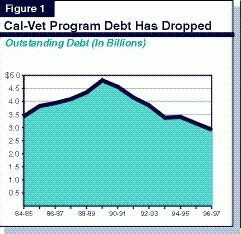
Program Eligibility
SB 574]) which took effect on January 1, 1998,
peacetime veterans who served outside of
those defined wartime periods will be eligible for
Cal-Vet home purchase assistance for the first
time. Whether his or her military service was in
wartime or peacetime, an applicant for Cal-Vet
assistance generally must have served at least 90
consecutive days on active duty unless the veteran was
discharged for a service-connected disability.
Program Administration
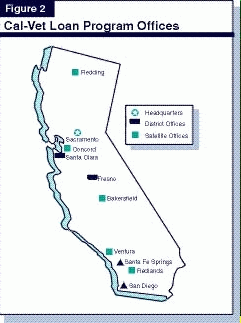
January 1, 1977, and who also were released from active duty within the last 30 years. The
maximum loan on a single-family home purchase is $250,000, with a maximum of $300,000 for
farm purchases and $70,000 for mobilehomes. There is no limit on the price of the home
purchased through the program, and no limit on the income of the veteran, as long as general
obligation bonds are the source of Cal-Vet assistance.
LAO Findings
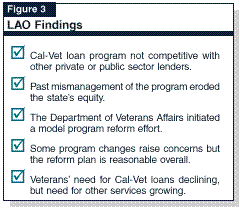
Cal-Vet Program Not Competitive
Cal-Vet Loans Attractive in Past
Cal-Vet Not Competitive
Now With Private Lenders
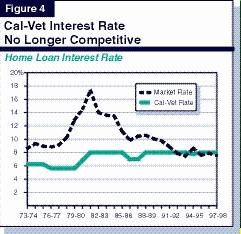
Cal-Vet Faces Competition From
Federal VA and Other Government Programs
How Lack of Competitiveness
Has Affected Cal-Vet
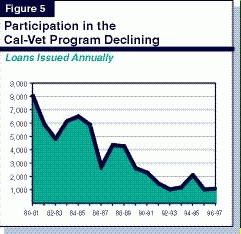
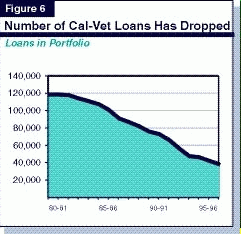
Mismanagement Eroded
State's Equity in Program
Financial Losses Suffered
Five Years in a Row
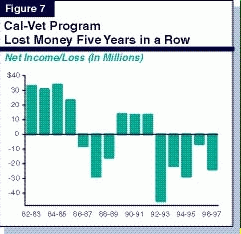
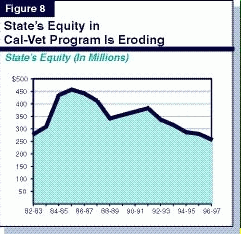
Program Remains Financially Secure
Why Has the Program Lost Money For Five Years in a Row?

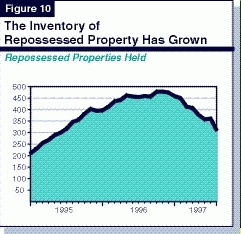
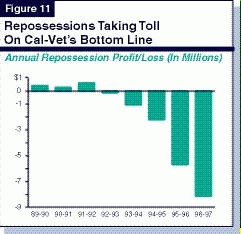
Weak Management and Operations
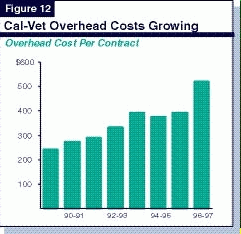
The "Reengineering" of Cal-Vet